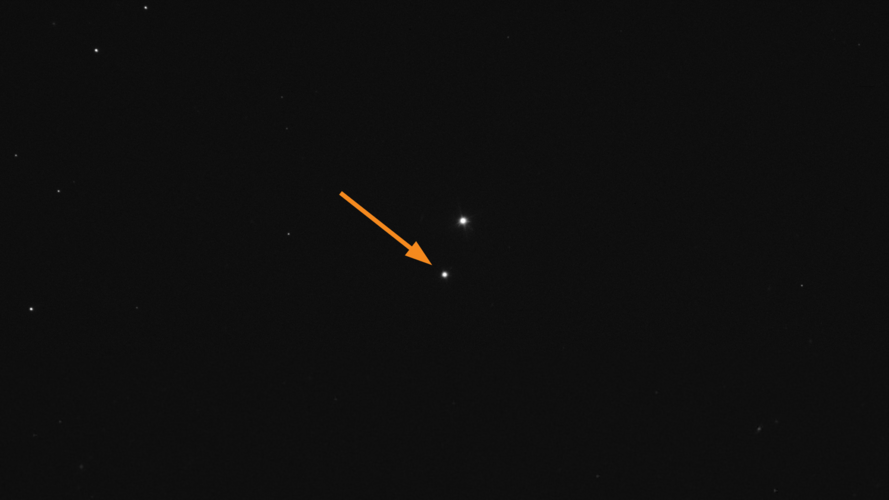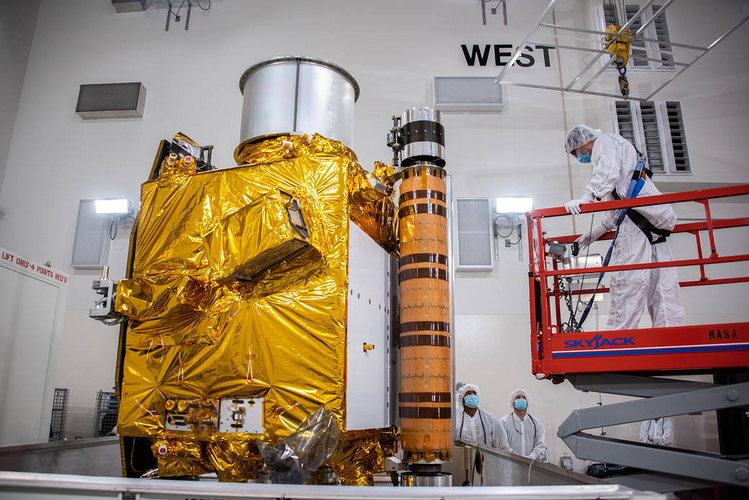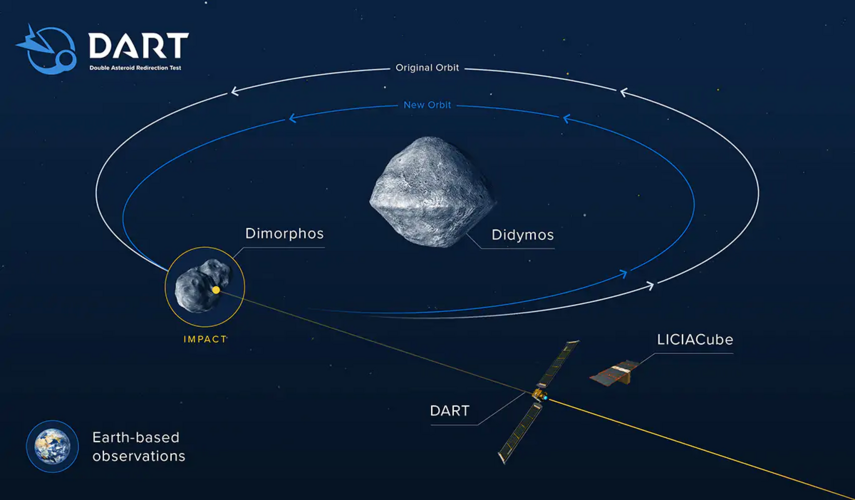- Joined
- 21 January 2015
- Messages
- 12,157
- Reaction score
- 16,373















Technicians prepare to move NASA’s Double Asteroid Redirection Test (DART) spacecraft from a shipping container onto a work stand inside the Astrotech Space Operations Facility at Vandenberg Space Force Base in California in this image from Oct. 4, 2021.
DART was launched on Nov. 23, 2021, aboard a SpaceX Falcon 9 rocket from Vandenberg. The spacecraft will intentionally smash into the moonlet Didymos on Sept. 26, 2022, to see if this method of asteroid deflection—known as the kinetic impactor technique—would be a viable way to protect our planet if an asteroid on a collision course with Earth were discovered in the future.
Image Credit: USSF 30th Space Wing/Aaron Taubm
Last Updated: Sep 26, 2022
Editor: Monika Luabeya


ATLAS observations of the DART spacecraft impact at Didymos! pic.twitter.com/26IKwB9VSo
— ATLAS Project (@fallingstarIfA) September 27, 2022
ATLAS observations of the DART spacecraft impact at Didymos! pic.twitter.com/26IKwB9VSo
— ATLAS Project (@fallingstarIfA) September 27, 2022
DART: Another remarkable view of this evening's impact, this one from a 1-meter telescope at the South African Astronomical Observatory, Cape Town: https://t.co/oFnQjG4BDw
— William Harwood (@cbs_spacenews) September 27, 2022
DART's final moments before crashing into an asteroid 6.7 million miles away from Earth earlier today 😲 pic.twitter.com/GFeWP6UdQM
— Latest in space (@latestinspace) September 27, 2022
Really hoping we get some close up shots of Didymos post impact. Would love to see what sort of structure we're dealing with here.
Some more about Didymos impact pic.twitter.com/b3ulpVPJVw
— KB. (@thecolomb7710) September 27, 2022
JHUAPL say that the #DARTMission image below shows a region 31m wide. By my calculation that would be an image scale of roughly 3cm/pixel. I've dropped a small, blue figure into the frame to show how big a 160cm tall human would be in this scene.
— Will Gater (@willgater) September 27, 2022
Credit: NASA/Johns Hopkins APL pic.twitter.com/dwXsFnEUMo
#DARTMIssion impact on Dimorphos observed by Shanghai Astronomical Observatory pic.twitter.com/5spSRLESQb
— China 'N Asia Spaceflight 🚀𝕏 🛰️ (@CNSpaceflight) September 27, 2022
Hecho ¡merci por apuntarmelo!
— landru79 (@landru79) September 27, 2022
James #Webb Space Telescope
NIRCam Imaging Near-Earth Objects
Didymos #Dart Impact
filter: F070W SUB400P
2022-09-26 21:55:53 >> 2022-09-27 03:05:27https://t.co/A7VqzQoZpC
NASA/ESA/CSA/STScI/j. Roger pic.twitter.com/aR42us53jU
Last night, @NASA's #DARTMission intentionally smashed into an #asteroid in the world's first test of #AsteroidDeflection. No-one knew exactly what to expect - this has never been done before.
— ESA Operations (@esaoperations) September 27, 2022
Our results of this historic <30 min period in a few seconds👉https://t.co/eDkTfIMVLS pic.twitter.com/dW2SY9bBLS
The preliminary preview images from @LICIACube show the extent and shape of the plume from the #DARTmission Sept. 26 impact on asteroid Didymos' moonlet Dimorphos pic.twitter.com/VwUm096Yov
— Jason Major (@JPMajor) September 27, 2022
I’m shocked by the streamers in the ejecta. In ordinary granular splash experiments we see nothing like this. A few musings about this in a thread… /1 https://t.co/p5BTjIudAi pic.twitter.com/uQc9cxXOFI
— Phil Metzger (@DrPhiltill) September 27, 2022
Good thread about the impact.
View: https://twitter.com/DrPhiltill/status/1574905023888334858I’m shocked by the streamers in the ejecta. In ordinary granular splash experiments we see nothing like this. A few musings about this in a thread… /1 https://t.co/p5BTjIudAi pic.twitter.com/uQc9cxXOFI
— Phil Metzger (@DrPhiltill) September 27, 2022


Asteroid-smash aftermath: Why Europe is sending a probe to DART-battered Dimorphos
'We need a spacecraft detective that comes on the site and gives us the final outcome details.'www.space.com
Teamwork makes the dream work For the first time, @ESA_Webb and @HUBBLE_space have observed the same target at the same time. And it's not just any target... it's the aftermath of the #DARTMission collision with #asteroid Dimorphos!
Teamwork makes the dream work 🤜🤛 For the first time, @ESA_Webb and @HUBBLE_space have observed the same target at the same time.
— ESA Science (@esascience) September 29, 2022
And it's not just any target... it's the aftermath of the #DARTMission collision with #asteroid Dimorphos! 🛰️🪨
More info 👉 https://t.co/bbENdwU98r pic.twitter.com/33E6EWnMb4

Already got you covered with ESA’s Hera mission, see video up thread.
Asteroid-smash aftermath: Why Europe is sending a probe to DART-battered Dimorphos
'We need a spacecraft detective that comes on the site and gives us the final outcome details.'www.space.com
We need a follow up probe to look at what the damage was that DART caused to Dimorphos. Let's see what becomes of the European mission, it will be interesting know how much of the surface was blown off the asteroid and also what happened to Dimorphos's orbit.
Already got you covered with ESA’s Hera mission, see video up thread.
Asteroid-smash aftermath: Why Europe is sending a probe to DART-battered Dimorphos
'We need a spacecraft detective that comes on the site and gives us the final outcome details.'www.space.com
We need a follow up probe to look at what the damage was that DART caused to Dimorphos. Let's see what becomes of the European mission, it will be interesting know how much of the surface was blown off the asteroid and also what happened to Dimorphos's orbit.




Last night, @SARA_Obs Chile: Didymos/Dimorphos dust trails. 7x5m tracked on asteroids, stars filtered. WNW trail extends to 165", projecting to ~8600 km. (0410-0500 UT 30 Sept., ~78 hours after impact, R band) pic.twitter.com/4NJkxVEqz9
— William Keel (@NGC3314) September 30, 2022
Last night, @SARA_Obs Chile: Didymos/Dimorphos dust trails. 7x5m tracked on asteroids, stars filtered. WNW trail extends to 165", projecting to ~8600 km. (0410-0500 UT 30 Sept., ~78 hours after impact, R band)
Like lunar raysGood thread about the impact.
View: https://twitter.com/DrPhiltill/status/1574905023888334858I’m shocked by the streamers in the ejecta. In ordinary granular splash experiments we see nothing like this. A few musings about this in a thread… /1 https://t.co/p5BTjIudAi pic.twitter.com/uQc9cxXOFI
— Phil Metzger (@DrPhiltill) September 27, 2022
Interesting that the impact of DART created streamer’s, I wonder what could have caused them?
